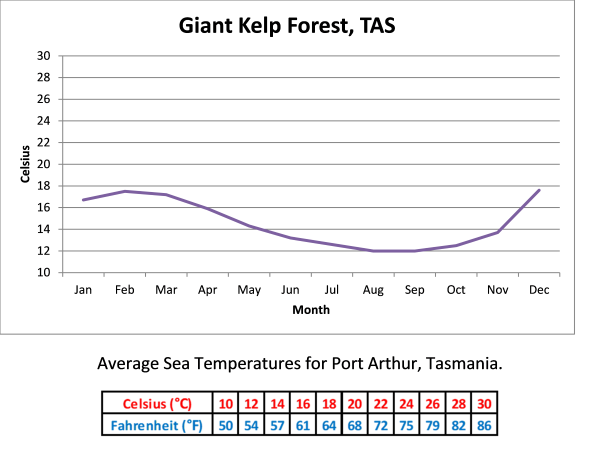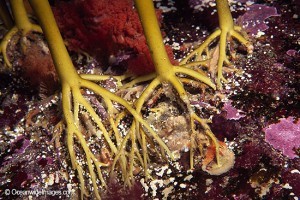GIANT KELP FOREST
|
| Type of dive: |
|
Kelp Forest |
| Snorkelling: |
|
Yes, like flying in a rainforest! |
| Scuba: |
|
Open Water |
| Access: |
|
Boat only (45 minutes) |
| Depth: |
|
8 – 18 metres (25-60’) |
| Visibility: |
|
8 – 30 metres (25-100’) |
| Water temperature: |
|
12 – 18°C (54-64°F) |
| Seasonal: |
|
No, but October to December & April to June best |
Australia’s cool southern waters support massive growths of seaweed, some of which form giant underwater kelp forests.
The world’s most diverse marine plant environments exist in the cool nutrient-rich temperate waters of South East Australia, mainly in Victoria and Tasmania.
Giant kelp (Macrocystis pyrifera) is one such seaweed consisting of long fronds often reaching lengths in excess of 45 metres (150’). Each frond is anchored to the bottom rock substrate by a holdfast and supported by gas bladders (pneumatocysts). Fronds grow in dense strands and often form a thick floating canopy on the surface.
In ideal conditions, giant kelp can grow an incredible 0.6 metres (2’) per day!
Giant kelp forests support and protect many marine species such as sea urchins, sea stars, crabs and many species of fish.
Giant kelp grows best in water which is less than 20°C (68°F) and is one of many species seriously threatened by increased water temperatures, refer to the Footnote below.
Unfortunately, over the last 20 or so years, many of Australia’s giant kelp forests have either disappeared or are disappearing.
The disappearance of over 90% of Tasmania’s giant kelp forests is believed to be a result of climate change causing water temperatures to increase. Particularly in winter where the average minimum temperature has risen from 10°C (50°F) to 12°C (54°F).
Lack of rainfall affecting associated nutrient run off is another possible cause.
Giant kelp is a primary source of alginates, emulsifying and binding agents used in cosmetics, and food stuffs such as ice cream.
Giant kelp forest is just like an underwater tropical rain forest, subtle lighting creates a peaceful feeling of tranquillity, only broken by curious playful seals from nearby colonies who are regular visitors.
Large schools of fish frequent the kelp forest, as do a variety of wrasse and trumpeter fish.
Elusive weedy seadragons also inhabit the forest floor amongst a host of other fascinating bottom dwellers, including abalone and brightly coloured sea stars.
Whilst the forest is present all year round, it is best observed either in late spring and early summer from October to December or in late autumn and early winter from April to June.
Put simply, diving in a giant kelp forest is absolutely awesome, and it is so sad that Tasmania’s forests are all but gone.
FOOTNOTE: Sadly, nearly all of Tasmania’s giant kelp forest has now disappeared, there are some small crops still left on the Tasman Peninsula and near Hobart. Currently, efforts are underway to replant areas with a more temperature resistant variant. However, there is a long way to go because the recently introduced sea urchins from New South Wales are trimming the fronds back before they can become established. Increased sea temperatures of only one or two degrees due to climate change are a cause for real concern and urgent action.
Special thanks to Karen Gowlett-Jones from Eaglehawk Dive Centre.
Copyright © 2024 Steve Sinclair
Other great dives to do while you are there:
SS Nord, Cathedral Caves, Waterfall Caves, Sister Rocks, Hippolyte Rock Seals and Port Arthur.
Local dive services:
|
|
EAGLEHAWK DIVE CENTRE |
|
|
GO DIVE TASMANIA |
Other services:
|
|
Need somewhere to eat, drink or stay? |
 |
BLAST EXPERIENCES |






OTHER INFORMATION
LOCATION
State or Territory:
Tasmania
Nearest City:
Hobart
Nearest Regional City:
Not applicable
Nearest Town:
Eaglehawk Neck
HOW TO GET THERE
Air:
Nearest International Airport:
Melbourne
Nearest Domestic/Regional Airport:
Hobart/Launceston
Road:
Hobart to Eaglehawk Neck:
Just over 1 hour (76 km/47 mi) via A9
Launceston to Eaglehawk Neck:
Just under 3 hours (235 km/145 mi) via National Highway 1/A3/A9
Bus:
From Hobart or Launceston
Train:
Not available
Ferry:
Melbourne to Devonport (Spirit of Tasmania)
THINGS TO DO
Tasman Arch
Tasman Blowhole
Devil’s Kitchen
Waterfall Bay
Whale Watching
Port Arthur Convict Settlement





















